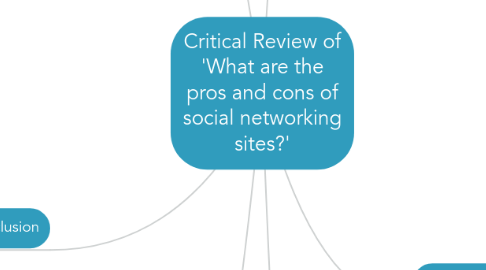Critical Review of 'What are the pros and cons of social networking sites?'
by Eeling Yeoh


1. References
1.1. Topping, A. 2012. 'Social Networking Sites Fuelling Stalking, Report Warns'. Retrieved April 24th, 2018, from https://www.theguardian.com/technology/2012/feb/01/social-media-smartphones-stalking
1.2. Chugh, R. 2017. 'Facebook is fighting social media identity theft in India, but it's a global problem'. Retrieved April 24th, 2018, from https://techxplore.com/news/2017-08-facebook-social-media-identity-theft.html
1.3. Simon, M. 2008. 'Freed student uses Twitter to demand translator's release'. Retrieved April 24th, 2018, from http://edition.cnn.com/2008/TECH/04/25/twitter.buck/
1.4. Simon, M. 2008. 'Twitter saga ends in jailed translator going free'. Retrieved April 24th, 2018, from http://edition.cnn.com/2008/TECH/04/25/twitter.buck/
1.5. Gaille, B. 2017. '29 Social Networking Addiction Statistics'. Retrieved April 24th, 2018, from https://brandongaille.com/28-social-networking-addiction-statistics/
1.6. Daly, J. 2012. 'How Is Facebook Affecting College Students' Grades'. Retrieved April 24th, 2018, from https://edtechmagazine.com/higher/article/2012/07/how-facebook-affecting-college-students-grades-infographic
2. Body paragraph 3
2.1. I disagree that social networking may even get a person out of jail.
2.2. James Karl Buck was arrested in Egypt because of his act of covering anti-government protest rally.
2.3. He was freed from jail not because of the post on Twitter but the post which helped him to get contact to secure his release as he was an American.
2.4. His translator, Mohammed Maree did not get out of jail because of the Twitter post and was continued to be detained until Buck contacted the Egyptian Consulate in San Fransisco and posted a petition for Maree's release.
2.5. In this case, James Karl Buck and Mohammed Maree were not guilty of the charges, they were just presumably falsely accused.
2.6. The social media, Twitter, was used as a platform to seek help from other people, not as a way to escape from legal obligation.
2.7. That Twitter post enabled Buck to disclose his current condition, the urgent message is proof of the value of Twitter, Stone said. Buck's entry set off a chain of events that led to his college hiring a lawyer on his behalf. On his way to the police station, Buck sent a message to his friends by using the micro-blogging site Twitter. It took the signatures and support of thousands of activists to get his translator out.(Simon, 2008)
3. Conclusion
3.1. I agree that social networking makes identity theft easier. Besides, I also agree that social networking can be both overwhelming and addictive at the same time. On the other hand, I disagree that social networking may even get a person out of jail.
3.2. In a nutshell, there are many boons and banes of using the social networking sites.
3.3. If social networking sites are used in moderation, users can absolutely reap boundless benefits from these social networking sites.
3.4. On the contrary, the users may be led down a menacing avenue if they lack self-control and fail to use the social networking sites judiciously.
3.5. Social networking is a double-edged sword. Therefore, users should be clear of their intentions of using social networking sites and utilise them wisely and mindfully.
4. Introductory paragraph
4.1. The article entitled 'What are the pros and cons of social networking sites?' by Strickland,J focuses on the advantages and disadvantages of social networking sites.
4.2. Pros:
4.2.1. Social networking sites let users make connections with other people.
4.2.2. Users can use social networking sites to network professionally.
4.2.3. Social networking sites make the organisation of an event and invitation of friends more effortless.
4.2.4. Social networking sites can be utilised to promote an artiste's or actor's work.
4.2.5. Social networking sites also act as application platforms.
4.2.6. Social networking may even get a person out of jail.
4.3. Cons:
4.3.1. Online social networking makes identity theft easier.
4.3.2. Scammers use social networking sites to trick people into downloading malicious software.
4.3.3. Social networking can be both overwhelming and addictive at the same time.
